#AskTamara: How can I tell if my vintage Tupperware plastic cups are toxic? By Color? By Shape? By Age?
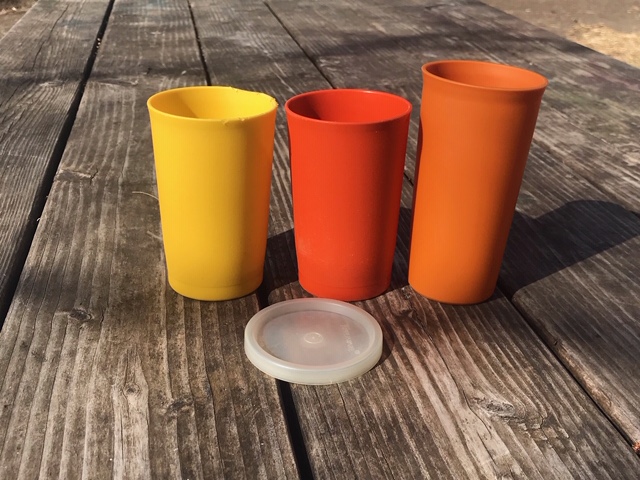
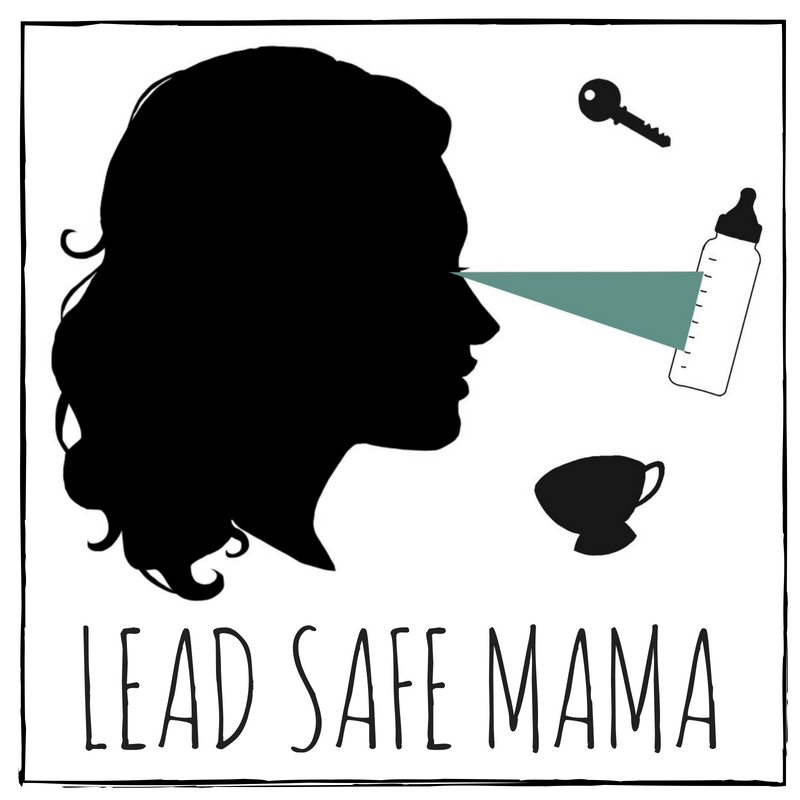 New post! First in a series of four that I will be doing to try to draw some distinctions between the Tupperware pieces WITH toxicants (Lead, Mercury, Cadmium and Arsenic) and those without. If you have any information or links to help inform this conversation (for example information about years made for certain model numbers?) that would be very helpful and I will update the posts accordingly! Thank you!
New post! First in a series of four that I will be doing to try to draw some distinctions between the Tupperware pieces WITH toxicants (Lead, Mercury, Cadmium and Arsenic) and those without. If you have any information or links to help inform this conversation (for example information about years made for certain model numbers?) that would be very helpful and I will update the posts accordingly! Thank you!
Originally posted: March 17, 2019
Updated: December 28, 2019
How can I tell if my vintage Tupperware plastic cups are toxic?
By Color? By Shape? By Age?
My best and first answer is that, from a lay person’s perspective (specifically someone who is not highly-experienced in consumer goods testing) or from the perspective of someone who does not have direct access to expensive scientific testing equipment (like most of my readers), or from the perspective of someone who is not an expert in the nuances of all of the different models, styles and colors of vintage Tupperware (I haven’t yet found that expert!), it is nearly impossible to tell the difference between the more toxic Tupperware pieces (the vintage ones that have been testing positive for Lead, Cadmium, Arsenic and Mercury) and some of the newer ones (that had BPA until 2010 and – by the company’s statement – have been BPA-free since 2010.)
Also, by way of a response to some of the questions on my blog over the past week, it is important to note that the Lead found in some of these products is not detectable with a home-test-kit (like the reactive agent LeadCheck® swab kits.) Those home kits were primarily designed to work on painted coatings and they were never intended to react to solid plastic substrates, so that is also not a tool that can be used by the average consumer to determine if these have toxicants. You can read more about that here.
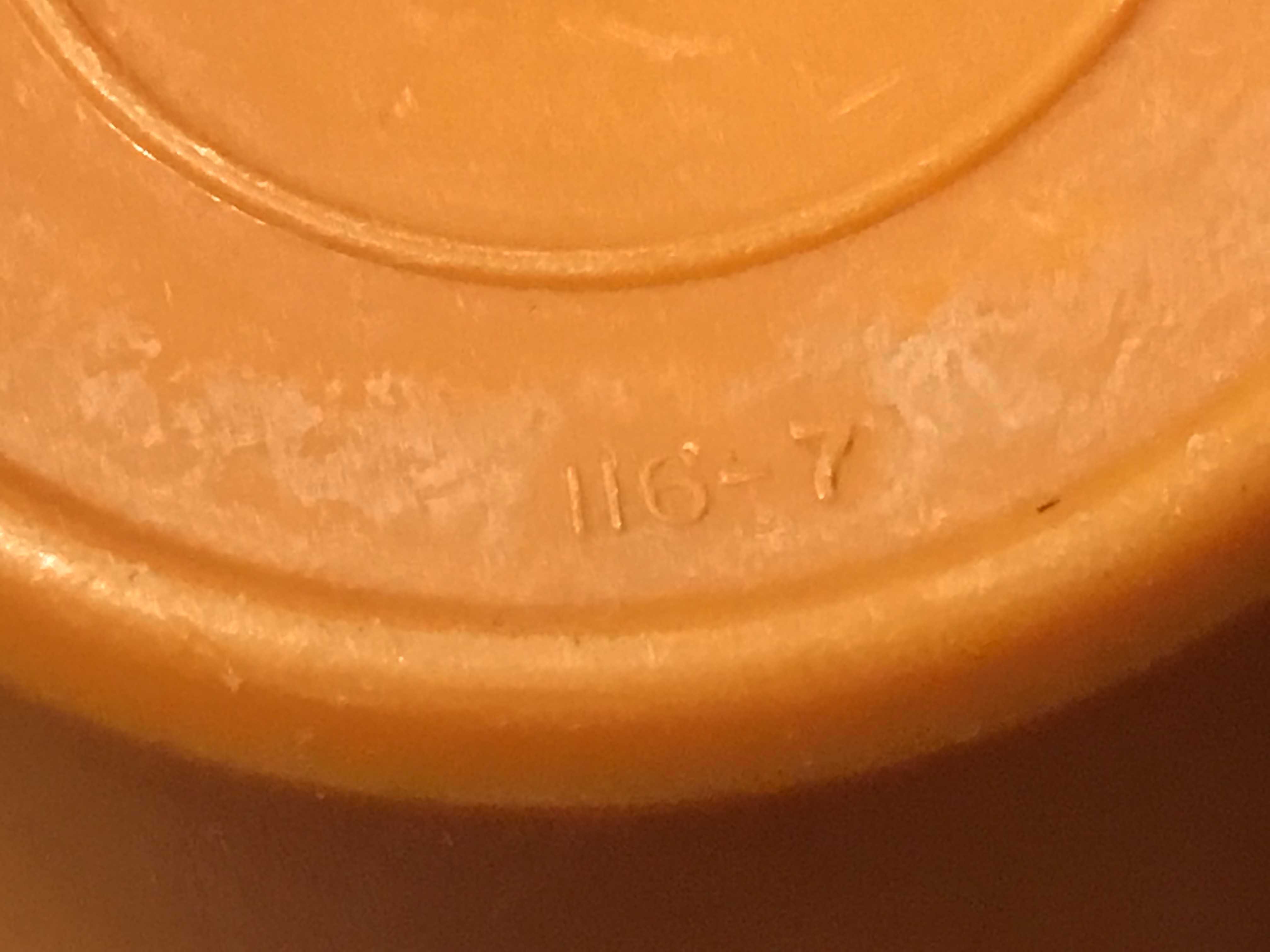
#1.) Color Orange in General:
You cannot simply surmise that the orange cups might have heavy metals (the lighter orange cup on the far right of the three tested negative for Lead, Cadmium, Arsenic and Mercury). The model numbers on the bottom of that cup are: 116-7. There is also an “E” on the bottom of the cup.I think, based on the style and differences in markings on the bottom, that this is possibly a newer shape and style of cup than the two other (shorter) cups pictured.
#2.) Cup Shape and Size:
You cannot simply surmise that the shorter cups (which are perhaps the older style?) have (or do not have) toxicants. The yellow cup on the far left seems – by shape, design, weight and texture – to be of the exact same era as the orange one in the center, yet it is negative for the four primary toxicants I test for (specifically negative for Lead, Cadmium, Mercury and Arsenic.) The model numbers on the bottom of the short yellow cup appear to be 1320-10 (or perhaps just “320-10”) along with a capital letter “F” & the model numbers on the bottom of the short orange cup appear to be 1320-7 (or possibly just 320-7) and there does not appear to be a letter stamped on the bottom of that cup.
#3.) Specific Color Orange:
Perhaps if you are a vintage Tupperware expert, you might assert, for the sake of argument (and I am just guessing at this), that the bright orange of the center cup was specifically only used during the early 1970s, and therefore that identifies that cup as having been made during a specific era (and perhaps you could say the same about the other colors being identifiable as being made during a certain decade…) which might therefore explain why it is that it’s the one cup (of the three shown here) that is positive for toxicants (both Cadmium and Mercury! – you can read the specific test results for that cup HERE.) However, shortly I will be publishing two follow up posts to this that argues that even that distinction seems to be uncertain. [I will link that post here as soon as I have it up.]
Click here to read (and sign) the petition asking for Tupperware to formally respond to this concern!
Of course, if any one of my readers can give me more verified information about colors, styles, and model numbers in relation to manufacturing periods (any information that might help pinpoint which production years and which styles could be more likely to have heavy metals) that might be helpful…but it seems that many of the styles (specific shapes) were re-introduced across different decades, and the same appears to be true about the colors (based on the research and testing I have done so far.)
My conclusion…
So my conclusion on this one is the simplest answer (and likely the least-satisfying answer to the reader): casual user of Tupperware cannot readily know which style or color might have toxicants based on the style, color or model number of that piece. I think for this reason, if you insist on using plastic Tupperware products (vs. safer modern non-plastic alternatives), sticking with post-2010 Tupperware products (because then you also know they are going to be BPA-free) is the best piece of advice for avoiding heavy metals in “Vintage” Tupperware.

Important point to note:
The term “vintage” is defined as at least 20 years old, which would mean pre-1999 at this point, and I have tested plastics (from several different companies) made as recently as the early-1990s that have also been positive for high levels of Lead, so without further information, I would assert that it is possible (and even likely) that Tupperware products through as late as the early-1990s might also be positive for Lead.
Please let me know if you have any questions.
As always, thank you for reading and for sharing my posts.
Never Miss an Important Article Again!
Join our Email List


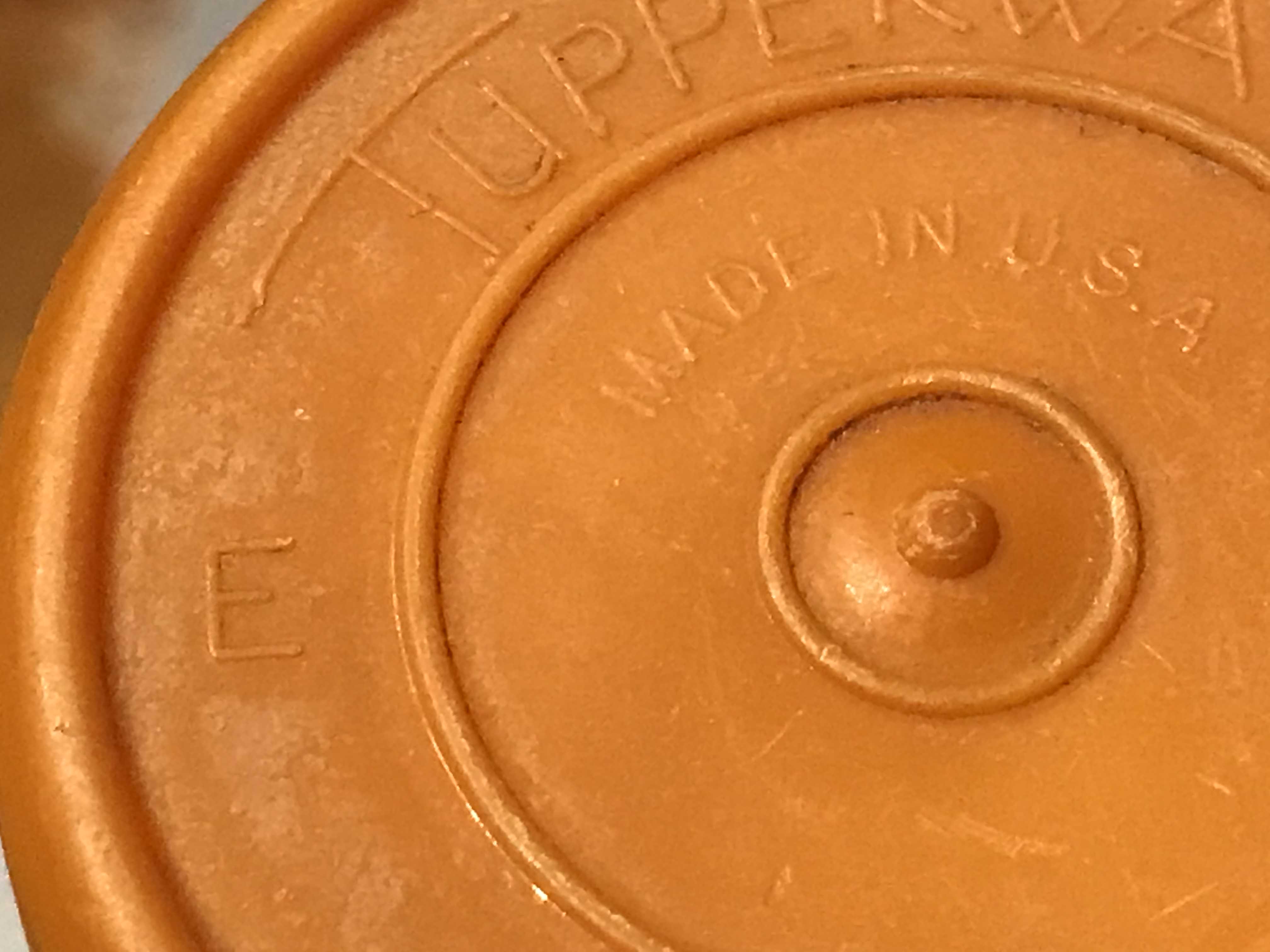
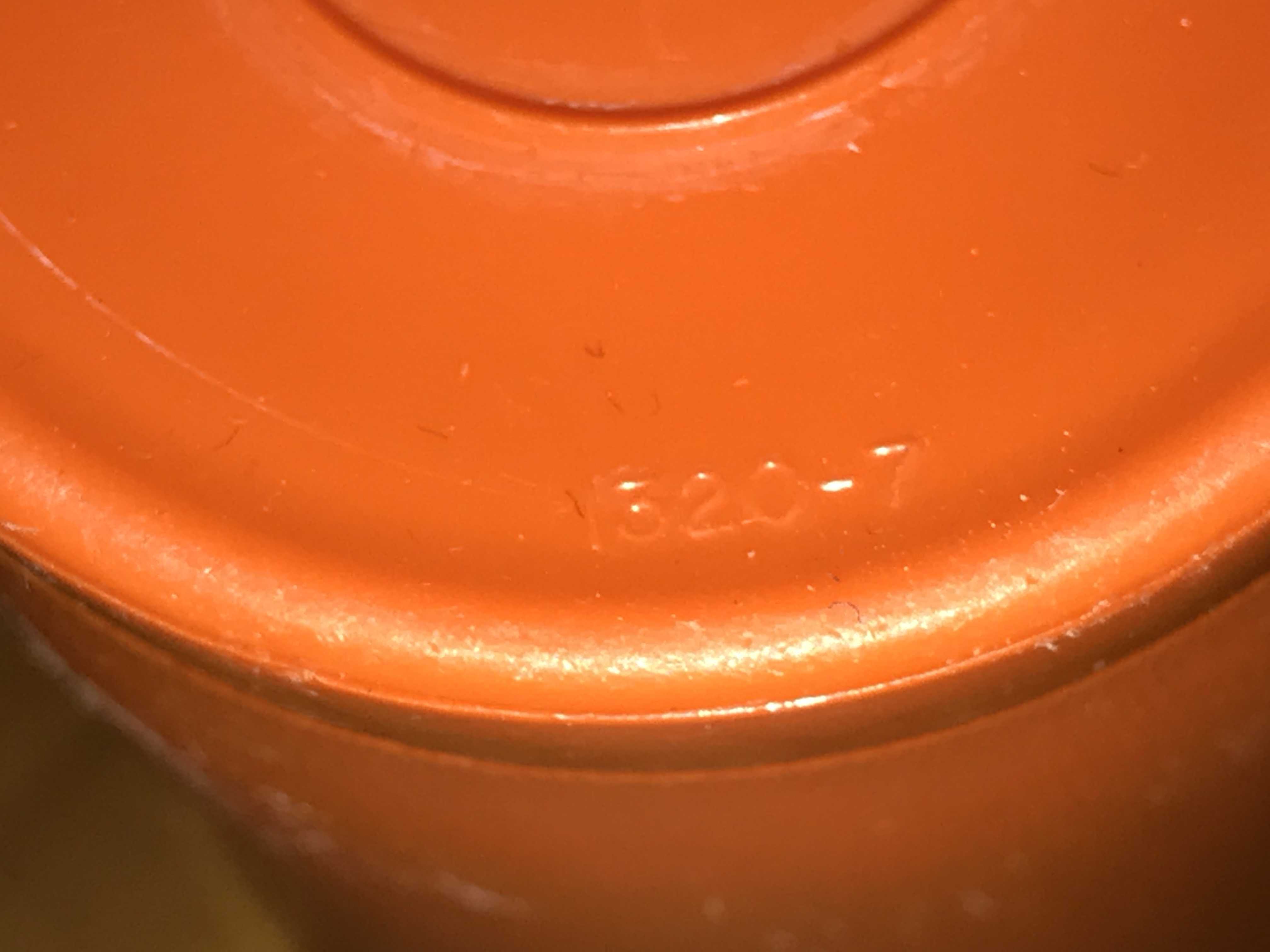
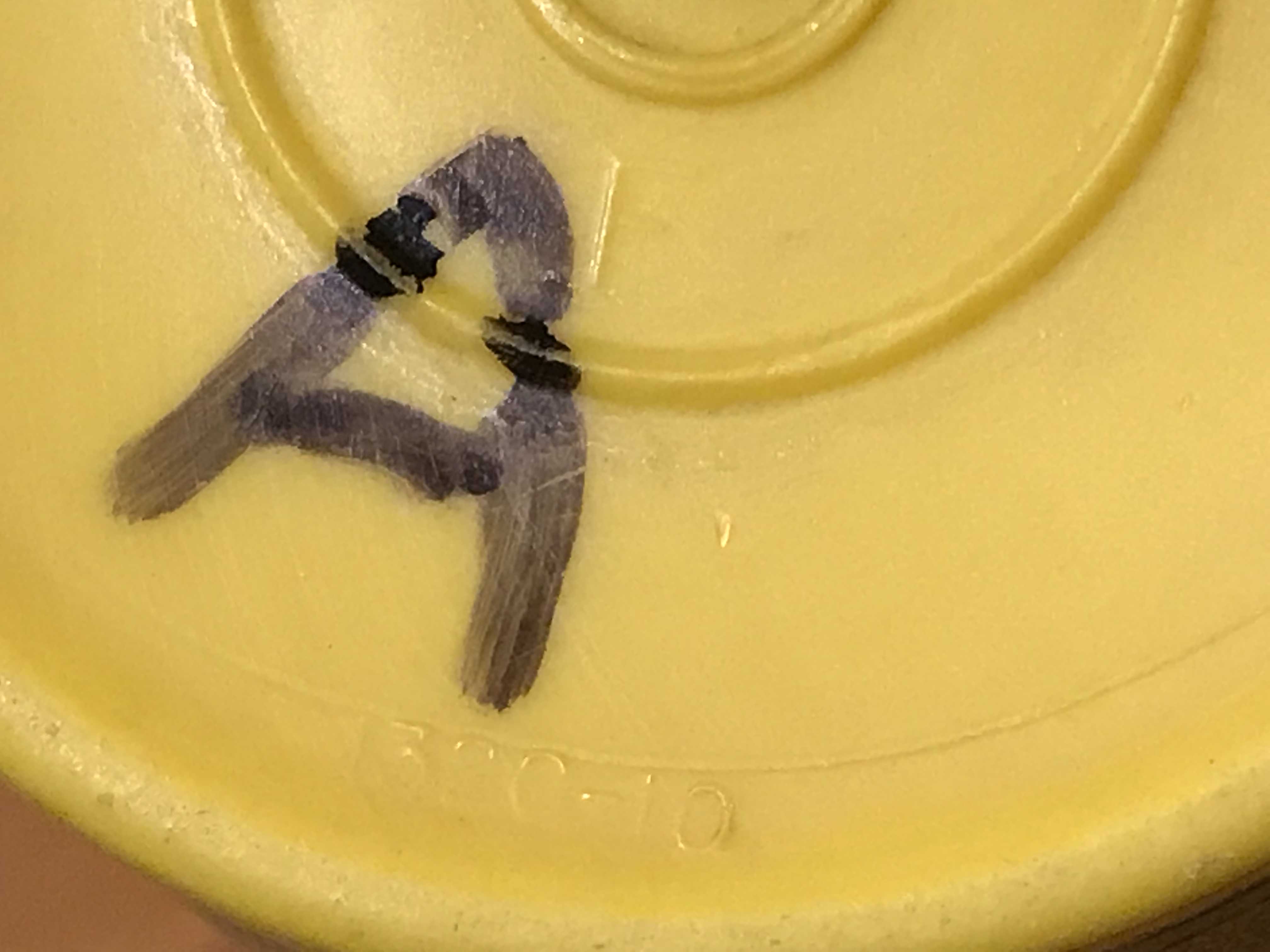

I have several Tupperware cups, shorter than these & with a flared lip, that were given to me by my husband’s grandfather for our young daughter to use & she’s been using them for the past 3-4 yrs. They had sippy cup lids, but I threw those away because we were starting to phase those out in our house. I’m uncertain how old these cups are. I have a red, a blue & a yellow that all say 109-28 on the bottom. A green that says 109-31 & another yellow that says 109-43. All 5 cups have the letter G. I always thought these were from the same set, but now that I compare the 2 yellows, one is slightly darker than the other. Wondering if we should continue to use them? I’d be willing to donate a couple if you would be willing to test them!
Hi Tosha!
Thank you for commenting!
Oh yes please I would love to test them and post the results here. Thank you so much. Which ever colors you would be willing to send would be good. I have not yet tested a red or a blue, although the yellows seem to be more likely to have toxicants than some of the other colors.
My shipping address is:
Tamara Rubin
Lead Safe Mama
7933 SE 15th Avenue
Portland, OR 97202
Thank you again!
– Tamara
Ok will do in the next week or two if not sooner. PS, my uncle lives in Portland not far from you! He’s about 6 blocks north of I-84. If you ever need a licensed massage therapist, look up LeRoy Meikle LMT! Thanks!
Thank you so much Tosha!
– Tamara
Did you receive and test any 109-43 G red ?
I have a microwave steamer dish. Yellow top and bottom. It is 50 years old. Also the cups mentioned and clear flour tub. Several keeper bowls Orange. I use them all the time. All at least 50 years old. Worried about them now.
Microwave ovens have not been around for 50 years. They were new technology in the mid 1970s. Even then, lots of people were wary of “microwave radiation”. By the 1980’s they were in most homes. We found a Tupperware 16oz tumbler at my mother-in-law’s house dated 1954. But they didn’t make things microwave-able until the ’80s.
These are the “Bell Tumblers”. I have a blue, green and yellow. 109-40, 109-42 & 109-43. I have an “orange” somewhere…probably in a cupboard storing ????
Did these test for Lead? I also have the measuring cups you show, having been using them for over 40 years! My mom was also a Tupperware Dealer. I have a lot of the older storage containers…the cereal bowls in the pastels, large green “salad” bowl, white storage containers, “orange” juice container, yellow container I used for “Kool-Aid”, tan container for juice or milk. Any results on any of these items??
What about lettuce and celery crispers from late 70s/80s? Have clear lids with green bottoms that are kind of a bright clearish spring green, not like the dull avocado color. Safe to use, just bought 2 new ones at an antique show cuz they work great
Hi Kay,
I haven’t tested those yet. If you subscribe to my e-mail newsletter or the RSS for the blog (those are both free), I’ll send out an update as soon as I have that. If you want to send stuff in for testing, here’s how to participate in that part of what I do: https://tamararubin.com/2017/07/subscribe-in-support-of-my-advocacy-work-you-can-become-eligible-to-send-in-a-box-of-your-things-for-testing/
Tamara
I have the celery crispers too from the early 70’s. I’d be interested in knowing what toxins are in them as well. I don’t use them now as most of my things are stored in glass.
I’m a Tupperware consultant over 20 years. I’m not disputing what you are doing. We all know that many items from our past could be toxic because at the time they were made the information was not known. Just for information, the first 3 or 4 numbers on the bottom of a Tupperware product is the mold number. The numbers after the dash I believe are the color numbers. As you continue testing you may want to make note of the color numbers to see if there are patterns. Many of the very old mold numbers are “obsolete” in that we can’t even provide warranty replacements to customers for those items but some molds are still in production, especially the seals. I had some of the ’70s colors (avocado, orange, yellow and brown) and found them to become very brittle and cracked. But I have many items from the 80s to today so am curious about them, especially the small yellow strainer that everyone seems to have. I posted in another reply that I’m also concerned about the BPA issue and interested to know if it causes thyroid issues from its fumes or from food stored in it. I have over 20 years of new old stock in my home so this would be of concern to me. Thanks and good luck with your endeavor. I may be able to send you some old products as well for testing as I clean out my mother’s home and some of my very old products. Thanks!
Thank you so much for this terrific and helpful comment Ann Marie! I will keep an eye on those numbers as I test more. With each post I try to include a photo of the bottom as well. It looks like some of the really old pieces have no number on the bottom at all… so the absence of a number might also help to date things, right?
Thanks again! Keep me posted if you have things you think you could send that would help the conversation. Right now here’s the post that I have with all of the pieces I have tested. So far the clear/white pieces are negative for any of the toxic metals: https://tamararubin.com/2019/03/is-my-tupperware-toxic-here-are-pictures-of-everything-i-have-tested-so-far-with-links-to-the-xrf-test-results/
Tamara
Every item has a mold number. In the very old products, it is in the middle area. I had a few vintage pieces from my mom and the number was within the circle on the bottom of the piece. Otherwise it is usually somewhere near the edge. The numbers are very hard to see (I use them to identify pieces for warranty replacements and sometimes they are impossible to make out, especially on the sheer items). There are some very old pieces from the 1950’s that have the outline of a seal (the animal) near the logo. Pieces that have a picture of a wine glass were made after 1973 and may be put in the dishwasher. Pieces from about the late 90’s/early 2000’s have the recycling symbol.
So, does this mean that the clear/white pieces are ok to use. But some of the lids are colored.
Is it possible that it is the hard plastic items are the ones with the metals?
Thanks
Have you reported your findings to the Consumer Product Safety Commission so that an official recall can be initiated?
Hi Gary,
Unfortunately they don’t do recalls on vintage or antique items.
Tamara
I’m wondering if they would make an exception for Tupperware as it has always been promoted as having a lifetime guarantee against breaking, cracking, chipping and peeling.
How did the test results turn out for the Tupperware cups with the letter G on the bottom?
I’m wondering about this as well! My mom gave me some cups stamped G 109-43 and my daughter went nuts playing with them, but now reading this I took them away! 🙁
I have the 1970’s gray color Tupperware parfait and dessert bowls with snap on lids . Do they have lead in them?
I have the dessert set, white with color stems. Or light blue stems… Also the white jello sets… I was going to donate them. Are these or the ice pop makers safe if white? I assumed they were BPA, at the leaat.
Pre-2011 has unsafe levels of BPA – so trash if possible.
T
Hi Tamara, Thanks for all this info about Tupperware! My FIL worked for Tupperware for most of his life as a mold maker. He would have been a wealth of information, but sadly he passed away many years ago. Unfortunately, most of the Tupperware we have is vintage passed on to us by my husband’s parents when we got married over 25 years ago. We used it for many years and then started phasing out most of our plastic and using glass instead for food storage. We do still have a few pieces that we still use, including the yellow measuring cups. I will be getting rid of all of our Tupperware. I can take a photo of what I have if you’re interested in testing anything. Just let me know. I’m happy to help.
Oh Donna! Thank you!
I would love some more examples to test and post on my blog. People really want to know if their exact item is positive (and for which toxicants), so that would be helpful for a LOT of people. Please send me a picture to TamaraRubin@mac.com and I will let you know which items I have not yet tested.
Thank you again, and thank you for commenting.
Tamara
Sounds good! I will send a photo very soon!
Donna
How about the Tupperware canisters? We bought some vintage at a garage sale in Mn before we moved to Japan. They are sort of an off yellow. We have been using then to store flour and rice. Have you done testing on these types of canisters?
Hi Stu,
Thank you for commenting. I haven’t yet tested any of the canisters – but I have tested several yellow items and will be adding more to the list soon. Here’s a link to the “Yellow Tupperware” category on my blog: https://tamararubin.com/category/yellow-vintage-tupperware/
Tamara
I was wondering about these canisters too. I have so much vintage Tupperware because I sold it for awhile in the late 70s.
I have the blue canisters. Hope they are safe.
Hi T. Are they the dark blue ones?
– Tamara
I have the dark blue canisters. Do you know anything about them? Are they safe? When were they made?
I have read with interest some of the testing you have done. Have you been able to determine if the various metals you are testing for can leach out of the plastic, or are they bonded in it to a point that they are stable within the plastic? I would be interested in knowing what the leach rate is (if any) and if it is worsened by increases/decreases in temperature.
Hi Jerry,
I would be interested in knowing that too. In the absence of leach testing I think refraining from using these items is the safest bet. I don’t do leach testing myself (yet) it is very expensive and I am not yet covering the costs of my advocacy work.
With other leach testing studies that I am familiar with hot liquids and acidic liquids are generally more likely to leach toxicants from dishware (with ceramic and crystal substrates for example) and so I would definitely avoid using vintage Tupperware with any heated food or beverages.
Tamara
Tamara,
Cleaning out grandma’s house and found an old Tupperware catalog from 1982. So many of the items used to be in my house and now are mostly replaced with glass and safer plastics. If it would be helpful I can take photos of the pages to email to you. It could help you possibly determine the year the pieces were made. It also states on a page that all products purchased after Sept. 3, 1979 are dishwasher safe. Also I read a disclaimer that Tupperware is not guaranteed for use in microwave oven as warping and melting could result. Please let me know if you want these pages emailed to you.
Thanks for all your hard work and not letting the mean people’s comments discourage you!!
Gail Simmons
Thank you so much, Gail!
I emailed you. I look forward to seeing those pages… I think that will be very helpful information to many of my readers.
Tamara
Is sold Tupperware way back in the early 80s. I don’t remember a ton about it because I only did it for a little while, but I do remember that the big letter E or F that you’re seeing on the bottom of the cups are only for the size of the “seal” / lid that will fit that cup. I have lots of those style cups that you’re showing in four different colors (yellow, burnt orange, burgundy, and a darker burnt orange) in 4 different sizes. I also have measuring cups and spoons in the burnt orange. I also have many other pieces… am I supposed to get rid of all of them? Are they all bad? What about the clear pieces from the same era? Is it only the colors?
Hi Jan,
I will have a few more posts up discussing that shortly, I will link them here when they are up. Thank you for the additional information to help me (and my readers) identify which ones might have toxicants.
Tamara
I have an orange gal. Pitcher and a yellow 2 gal. Should I just pitch them? They are from 1980s
I called Tupperware, and they said all their products are and always have been free of harmful chemicals, but I felt that was their prepared stock answer. I am sure they are petrified about what will happen to the company if they have to replace thousands or millions of stock (after all, they have a lifetime warranty…). I have been married 51 years, and I have over a hundred Tupperware products.
Tamara, have you tested any of the almost clear products, like lids, plain storage, etc.?
Thank you for doing this and keeping us safe!
Hi Holly!
Thank you so much for commenting. Yes – I have tested two of the white/clear products. The two I have tested have been lead-free (and free of other toxicants as well.) I would like to test more to confirm. I’d also like to test some of the white ones with speckles.
This is a post with all of the pieces I have tested (and I will be updating it periodically): https://tamararubin.com/2019/03/is-my-tupperware-toxic-here-are-pictures-of-everything-i-have-tested-so-far-with-links-to-the-xrf-test-results/
Tamara
I have several vintage Tupperware opaque white storage containers, such as 9×13, square, and round. I also have a pie carrier that has a yellow base with white cover. I have some cannisters I keep cookie cutters in. Have you tested any of these?
I would be more interested in those cheap dollar store cups they sell today that look similar to the vintage tupperware. may be more relevant as well.
Hi Lucy, I have several posts with Dollar Store items here on my blog. Most of them have been within safe range (or negative) for heavy metals (at least the new products from them). Here’s the category link: https://tamararubin.com/category/dollar-store/
Tamara
Hi Tamara. I am freaking out a bit. I used an old yellow (not bright yellow, but a brownish yellow) bowl to do some cleaning recently. The bowl is very old – likely from the 60s. I filled it halfway with hydrogen peroxide and dipped a rag in it, and I used the rag to sanitize several things around my house, including a bunch of my kids’ toys! Now I’m worried that the lead or other harmful metals may have leached into the hydrogen peroxide and that I spread lead-infected liquid all over their toys, which they have been playing with! What is the likelihood that the lead or other harmful metals leached into the hydrogen peroxide? At this point, what should I do to reclean their toys to ensure they aren’t harmed? Thanks for your help! The number on the bowl is 800-4.
Hey Tamara, sorry to bother you. Really appreciate all your hard work. I already left a message before. But I wanted to ask you if you could test my personal set of measuring cups? If i sent them to you by mail. Im a first time mom and a little terrified my 8 month old son could end up having poisoning from the set of orange measuring cups i would let him play with… He would bang them together and ofcourse he would put them in his mouth
They are made in Canada and have the #s CAN PAT 879518 / CAN Rd 31813
Thanks again
Rebecca
Sure. Do you know what year they were made? (or what year they were originally purchased?)
I will e-mail you. I am trying to get a few more examples for the blog, so people can see the difference among different years / products models and colors. I don’t think I have tested any “Made in Canada” product.
Thank you!
Hello. First, I would like to say I am saddened to learn about your two children being poisoned by lead. Secondly, thank you for all you do. Furthermore, would you be able to tell me if the Medelco teakettle is Cadmium-free? It says it is lead-free but fails to mention anything about Cadmium.
Referring to the cups way up at the top of this thread, I own all of them. The smaller ones came as a set with a green one and a brown one. I’m guessing early 1980s as I never went to a Tupperware party until then. The taller one came in a set of 4 in organy-red-goldish-butterscotch type colors. Hope this helps you date them. This was after the brown and green era. I also own a set of children’s toy cups, coffee mugs, plates, pitcher, cake taker given to my daughter in the late 80s. Again the same color family as the smaller cups above. She was born in 1983. Unfortunately for all of us, they make such a good product they last forever!
I used to sell Tupperware in the early 80s so I still have several of the coloured vintage items. My question is — what is the best way to dispose of them? I think they probably can’t be recycled so into the landfill they go?
Hi Tamara!
Like most people, I’ve had quite a few Tuppware pieces that I’ve used over the years but I’ve gotten rid of most of them. However, I still use my orange measuring spoons, orange measuring cups and the yellow strainer/colander quite regularly. I also have a set of four plates in dark blue, purple, dark green and a dark reddish color that we still use on a regular basis. Have you done any testing on the yellow strainer, the orange measuring spoons or this set of plates yet? I’m very interested to find out if they test high in anything because I have lupus, an autoimmune disease and I’m worried they may affect me more because of my compromised immune system.
Thanks!
I have many orange pieces, canister set, pitcher, funnel, etc. Would have been early 80s. I use very little because it gives off such a terrible odor that seems impossible to get rid of. I will be disposing of all of it now.
I have an old (1970’s or early 80’s???), with small numbers 274-12 on the bottom. Any info on this?
Ooops! I noticed (too late!) that my description was incomplete! It should read: I have a large, yellow, Tupperware bowl from the 70’s or early 80’s. Numbers on the bottom are: 274-12. I’ve thought about throwing it out since it is one of the few remaining Tupperware things I own, but I like the bowl and have hesitated throwing it out unless I need to. “Innocent until proven guilty”, maybe? Thank you!
Hi Tamara,
I’m guessing that “ppm” is an abbreviation for “parts per million” but would you please verify or correct me if my guess is wrong? Thanks.
Hi Suzanne! Yes, that is correct. – Tamara
Hi Tamara,
I have some old Tupperware from the late 50s and early 60s. I read somewhere that Tupper used polyethylene when he first started. Is this safe?? Also, I think the number after the mold number isn’t for color, but for the lot it was made in. The first being number 1 and gets higher in subsequent years. Thanks for your help. Deb
Hi Tamara! I found this post while hunting for info on why my Tupperware smells so bad. I was a dealer when I was in high school in the late 70’s. My kitchen used to look like the cover of one of their catalogs, everything in a Modular Mate. So far, only my Modular Mates are smelling bad, none of the old Square Rounds are suffering and neither are any of my older pieces. My MM collection is 40 years old now and they all seemed to ‘go bad’ at once. I had to throw out a LOT of food. A whole container of cookies became inedible after a single night in a MM. I have removed them all and replaced with glass, which is not easy. (I strongly recommend you increase the support on upper kitchen cabinets, mine did not appreciate the increase in weight!) I tried using them for craft supply storage, but soft goods like ribbon & lace sucked up the bad smell too! I have not contacted the dealership about replacement because I doubt they will replace them, but it might be worth a shot. Also, the single letters on the bottom correspond to the lid size, lids will have the same letter, on the tab if they have one. Any base & lid with same letter will work together.
How should we get rid of our Tupperware items. I have been using the measuring cups. Spoons, containers, kids toys, etc for nearly 50 years.
Hi Tamara, I wanted to let everyone know that the Letter embossed on an item (all by itself, no numbers) corresponds to the lid size. All lids have the letter too regardless of color. Any ‘B’ lid will fit on anything with a ‘B’ on the bottom.
I have transferred my Tupperware to craft supply storage.
Thank you so much for commenting Valerie!
Tamara
Hi Tamara, Just wanted to let you know that
tupperdiva. com has old Tupperware catalogs on line from the 1950’s and 1960’s.
Thank you Deb – I will take a look at that!
– Tamara
Hi Tamara,
I can’t seem to find any data on your site about Australian Made Tupperware, maybe can’t see for looking! Can you advise at all on the safety of those Tupperware products made in Australia please?
Thanks so much ~ Bronwyn
I didn’t read through all the many comments, so my apologies if this is a repeat.
I sold Tupperware in the early to mid-1980s so I can share a few things.
The capital letters on the bottom of pieces corresponds to the seal that fits it that also has the same letter. It is meant to make it easier to find a seal that fits. Some items used the same size seal so you could interchange them.
The item numbers underneath that are in the xxxx-xx format is the part number (we used these for ordering replacements). The first 4 digits are the model number (so the size and shape) of the item. So all bell tumblers, for example, would have the same 4 digit number regardless of color or year it was made. I was thinking the last 2 digits corresponded to the color, but I just turned over and looked at a stack of snack cups and it did not seem to be that case as I had several in the same color for which that last 2 digits were different. They were all purchased at the same time as part of a set so the colors are all exactly identical.
I read that you’ve tested other companies’ plastic products from before 1999. Which other companies have you tested. We have a lot of older products in our home and we’d rather be safe than sorry.
Hi Lisa, just click the “vintage plastic” tab at the top of one of the posts (or the “plastic” tab) and that will bring you to related products.
Tamara
Married 5-4-85. Lots of Tupperware as wedding gifts that I’m still using-lots of gold! Gold canisters, cake holder, measuring cups (gold & orange). Please keep use updated. Do I just toss it all & buy new?
Hi Tamara
Thanks for your research. I live in Australia. I was wondering if the Tupperware here is likely to be contaminated too? I know the bottom of my Tupperware says “made in Australia”.
Would appreciate any information you have or may be able to gain, regarding this.
Many thanks
Paula
Hi Paula,
I don’t know that I have tested any with “Made in Australia” stamped on the back. I will keep an eye out for some of those. In general, however, I would assume that plastics formulations of that era (1950-1980) would likely be the same country-to-country – especially coming from the same manufacturer, as a I don’t recall ever hearing that any country was specifically ahead of the United States from a “toxicants in consumer goods” perspective in that era. In contrast, today – modern European products are almost always less toxic than their American counterparts – but that was not the case historically. I often find European products from even 10 or 20 years ago that are just as toxic as their American counterparts.
I’m trying to come to Australia to hopefully do some outreach events there. Here’s a post about that in case you have some connections or resources (or other ideas) that could help get me there! https://tamararubin.com/2019/08/lead-safe-mama-would-love-to-come-to-australia-join-our-australia-lead-safe-mamas-facebook-group-to-help-coordinate-a-trip/
Tamara
Hi Tamara,
I have some Tupperware Made in New Zealand from the 60s.
I’d be happy to send you a sample for testing if you wish – let me know.
Oh I am very curious to test that Kelly! What colors do you have? Orange, yellow and green are likely the most toxic and would be the best to test. Would you be sending from the U.S.? Is it marked with the words “New Zealand” on the bottom? Or a code or something indicating NZ?
Let me know. My phone number is 415-609-3182, my email TamaraRubin@mac.com.
Address:
Lead Safe Mama, LLC
7933 SE 15th Avenue
Portland, OR 97202
Thank you!
Tamara
They are all marked “Made in New Zealand” on the bottom. I have clear colour, orange and yellow. I’m not sure how old the yellow is, could be newer that the 60s.
The orange ones are 886-39. The clear one has the number 203-12 on the bottom of it.
I’m sending from New Zealand. Happy to email you photos if that helps.
That’s AMAZING! Thank you so much. I have had so many requests to test things from Australia and New Zealand. I really appreciate that you are willing to do this. When they arrive I will make sure they get tested and posted very quickly!
Tamara
Thanks Tamara, I’m planning to send you these in the next 2 weeks.
Kelly
The alphabet letter in caps on the bottom is to help you locate the lid faster. Lids are marked with a corresponding letter.
I know this post is old but the is one bit of info I didnt see anyone address. If there is a letter, by itself, on an item, it means that it has a lid. The lids have corresponding numbers.
Hi Tamera!
Thank you so much for commenting.
Tamara
thinking the little coffee cups and plates at lead infested?
The letters on the bottom of Tupperware indicated the seal size..such as the E you spoke of..it could be sealed with a matching E seal. The larger bowls were Z.
Hi Jeanene!
Thank you so much for commenting.
Tamara
Hi Tamara! I bought a Tupperware cup (short and dark orange) at an estate sale a while back. I ran it in the dishwasher (dumb idea) a few times with all my other dishes and noticed that the clear plastic started to have an orange tint to it! so I threw those things out along with the Tupperware cup.
Do I need to get myself and kids tested for lead??? I feel very uneasy about this now!
My mother was a manager in the 70s when I was in high school. I packed out her parties to earn cash. I remember two shades of yellow measuring cups and the other during that time. One is more muted and sold with avocado green sets. The other is a bright yellow.
I’m wondering about plastic drinking cups from the 90’s that are coloured.. my in laws still use the same cups and they seem kind of tattered and wore down, which I imagine can’t be good if they have some of these elements in them…is there an article specifically for those/would you want one sent to you for testing?
Thank you !
Tamara,
Just came across your site. I have the orange Tupperware measuring cups. I bought them in the early eighties and have used them since then. I’m shocked that the measuring cups that Ive used to cook for my family, husband, children aces now or grandchildren, might be toxic to them.